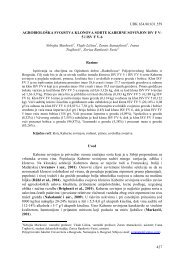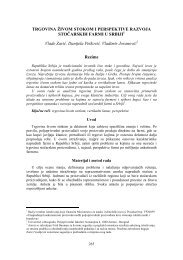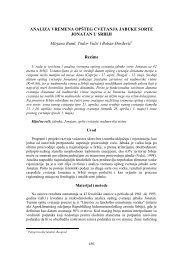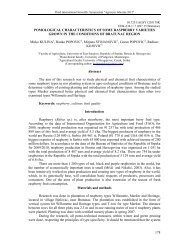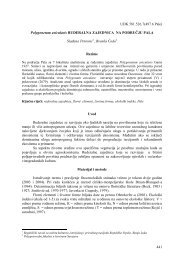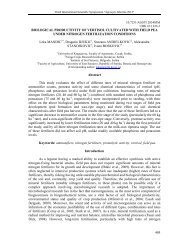PROFITABILITY OF MIXED FRUIT TREE FARMS IN ALBANIA ...
PROFITABILITY OF MIXED FRUIT TREE FARMS IN ALBANIA ...
PROFITABILITY OF MIXED FRUIT TREE FARMS IN ALBANIA ...
You also want an ePaper? Increase the reach of your titles
YUMPU automatically turns print PDFs into web optimized ePapers that Google loves.
<strong>PR<strong>OF</strong>ITABILITY</strong> <strong>OF</strong> <strong>MIXED</strong> <strong>FRUIT</strong> <strong>TREE</strong> <strong>FARMS</strong> <strong>IN</strong><br />
<strong>ALBANIA</strong><br />
Majlinda Çakalli 1 , Enver Brahimsulaj 2 , Endrit Kullaj 3<br />
Summary<br />
Fruit tree farms in Albania, as other agricultural farms, are characterised by their<br />
small size and diversification. Under different relief, unorganised market channels and<br />
unstable demand, fruit growers are faced with diverse alternatives to chose. This study<br />
aimed at identifying the most profitable combinations of mixed fruit tree species and<br />
accessory activities (crop and animal production) for different terrains.<br />
The research presented was conducted in Vlora region during 2008 - 2009<br />
analysing mixed fruit farms located at 3 different altitudes (< 150 m, 150 – 250 m and<br />
250 – 400 m) and slopes (< 5%, 5 – 15% and > 15%). A total of 71 farms were<br />
investigated, with a total surface of 133.52 ha, 62% of which was planted with fruit<br />
trees. Data collected was related to species and respective surfaces, total incomes from<br />
fruit trees and accessory activities, yields, production, costs and prices of products, net<br />
and per capita incomes, technology used, sale channels, sources of funding for new<br />
plantations and use of labour.<br />
The results showed that the most effective types of mixed fruit farms for each type of<br />
terrain and altitude. Accessory activities provide a considerable income, especially until<br />
the fruit trees enter into production. Such mixed farm will be dominant even in the<br />
middle term, especially in hilly and sloppy terrains. Among these activities, production<br />
of seedlings is very profitable but limited to lowlands.<br />
This study helps in assessing the profitability of fruit farms under different growing<br />
conditions and orients the fruit growers in better planning these investments.<br />
Key words: mixed fruit farms, profitability, sustainability, Albania<br />
Introduction<br />
The Albanian fruit sector today is characterised by issues related to land ownership,<br />
land fragmentarisation, small size, lack of capital for adequate investments, territorial<br />
extension of the ownership, inability of the Government to adequately support these<br />
sector, etc.). However, such family fruit farms are the main axis of the Albanian fruit<br />
sector and represent a continuously changing reality (MBUMK 2009).<br />
A medium- and long-term policy, with a clear programme is aiming at the<br />
intensification of the fruit tree sector by offering incentives to joint-ownerships,<br />
specialisation, introduction of modern technologies and high-potential cultivars, etc.<br />
However, the existence of mixed fruit farms (i.e. farms with several crops and/or<br />
animals with domination of fruit tree species) will remain the dominant type even in the<br />
1 Department of Agrarian Economics and Policies, Faculty of Economics and Agribusiness, Agricultural<br />
University of Tirana<br />
2 Agricultural Technology Transfer Centre of Vlora, Ministry of Agriculture, Food and Consumer Protection<br />
3 Department of Horticulture, Faculty of Agriculture and Environment, Agricultural University of Tirana<br />
524
long run because at the moment constitutes 70% of the total of farms. Even in the new<br />
plantings of fruit trees during 2007, out of 1045 farmers in 8 regions of the country, only<br />
6.5% of the surface was planted intensively (for olives more than 400 trees/ha, for fruit<br />
trees more than 600 – 800 trees/ha, etc.). Out of 500 fruit farms in the coastal area of<br />
Vlora, only 14 can be considered specialised. In this study, by analysing economical and<br />
financial indicators collected in eight communes of Vlora district to identify the best<br />
model of a mixed farm.<br />
Material and Methods<br />
This study covered fruit farms located in the coastal, central and mountainous area.<br />
The Vlora region under study has been divided into three zones depending on altitude, 0<br />
– 150 m, 150 – 200 m and 250 – 400m. Each zone has been further divided into subzones<br />
depending on the slope of the terrain, < 5%, 5 – 15% and > 15% which is an<br />
important determinant of the technology applied. A total of 71 fruit farms were<br />
included, totalling a surface of 133.52 ha. Out of this surface, 91.28 ha or 68.36% is<br />
planted with fruit trees, vineyards and olives. The rest is allocated to accessory activities<br />
like crop and animal production as well as fruit tree nursery. Thirty-two out of 39 farms<br />
cultivated two or three species of fruit trees. About 37.1% of the surface planted with<br />
trees has not entered into production yet.<br />
To identify the most opportune type of farm for each zone and sub-zone we have<br />
collected the following indicators using a structured questionnaire during the period<br />
2008 - 2009: species and surfaces, yields, cost and price of fruit tree products, total<br />
incomes from fruit trees and accessory activities, technology used, use of labour,<br />
sources of funds, etc.<br />
Results and Discussion<br />
Farms have been classified according to the altitude and slope into the pre-defined<br />
categories (Table 1).<br />
Table 1. Farms, surface and number of trees by zones and sub-zones.<br />
Zone Subzone<br />
No. of<br />
farms<br />
Surface<br />
(ha)<br />
Surface (ha) with plants<br />
in<br />
Number of trees in<br />
growth production growth production<br />
1 (÷5%) 24 36.90<br />
I<br />
2 (5-15%) 7 7.98<br />
3 (>15%) 8 9.1<br />
Total* 29 53.98 18.70 35.28 5087 4247<br />
1 (÷5%) 7 6.80<br />
II<br />
2 (5-15%)<br />
3 (>15%)<br />
not analysed due<br />
to small no. of<br />
farms<br />
Total 9 11.90 9.20 2.70 2426 296<br />
1 (÷5%) 26 21.4<br />
III<br />
2 (5-15%) 9 4.60<br />
3 (>15%)<br />
Total 33 26.00 13.6 12.1 2931 1794<br />
* Total farm no. is not the sum of individual farms because some extend to more than a sub-zone.<br />
525
From the data processing, mixed fruit farms have been categorised in different<br />
variants for each zone and sub-zone. Such variants or typologies have been then<br />
compared between them within the sub-zone, between sub-zones of a zone and between<br />
zones. Due to space constrictions of this publication we have listed them rather than<br />
showing in a table.<br />
Zone 1 Sub-zone 1: Fruit+Crop+Livestock (V1); Fruit+Livestock (V2); Fruit+Seedling<br />
prod. (V3); Grape (V4); Grape+Olive+Livestock (V5); Olive (V6); Grape+Seedling<br />
prod. (V7); Grape+Olive+Livestock+Crop (V8); Grape+Olive (V9);<br />
rape+Fruit+Livestock+Crop (V10); Grape+Fruit+Olive+Livestock+Crop (V11).<br />
Zone 1 – Sub-zone 2: Grape+Fruit+Olive+Crop (V12); Grape+Olive+Crop (V13).<br />
Zone 1 – Sub-zone 3: Olives (V6); Grape+Olive (V9); Grape+Fruit+Olive (V14).<br />
Zone 2 – Sub-zone 1: Fruit+Livestock (V2); Grape+Olive (V9); Grape+Fruit (V15);<br />
Grape+Livestock (V16); Grape+Crops+Livestock (V17).<br />
Zone 3 – Sub-zone 1: Fruit+Crop+Livestock (V1); Grape (V4); Olive (V6); Fruit (V18);<br />
Grape+Fruit+Olive+Livestock (V11); Grape+Livestock (V16); Olive+Crop+Livestock<br />
(V17).<br />
Zone 3 – Sub-zone 2: Grape+Fruit+Olive+Crop (V12); Grape+Livestock (V16);<br />
Olive+Crop+Livestock (V17); Olive+Livestock (V19).<br />
Tab. 2. Comparison of data between variants within a sub-zone (Zone I, Sub-zone 1)<br />
Farm typology<br />
(variant)<br />
Total<br />
Income<br />
Income<br />
from<br />
fruit<br />
Total<br />
expenditure<br />
Net<br />
Income<br />
Income<br />
per ha<br />
Income<br />
per<br />
capita<br />
V1 - FR+CR+LV 3146 3116 2044.9 1101.1 389.5 61.2<br />
V2 - FR+LV 620 435 403 217 435 36.2<br />
V3 - FR+SP 6000 - 4200 1800 6000 300<br />
V4 - GR 5763 5763 3857.7 1905.3 1405.6 52.9<br />
V5 - GR+OL+LV 585 485 320.1 264.9 1212.5 44.2<br />
V6 - OL 750 750 472.5 277.5 375 23.1<br />
V7 - GR+SP 3688 888 2618.5 1069.5 2634.3 89.1<br />
V8 - GR+OL+LV+CR 1630 1398 922.7 707.3 735.8 58.9<br />
V9 - GR+OL 850 850 561 289 425 16.1<br />
V10 - GR+FR+LV+CR 845 683 566.2 278.9 569.2 46.5<br />
V11-GR+FR+OL+LV+CR 758 715 471.9 286.1 446.9 23.9<br />
Total/Average 24635 16438.5 16438.5 8196.6 1329.9 68.4<br />
In Sub-zone 1, income from fruit production (incl. olive and grapevine) accounts for<br />
61% and income from accessory activities 39%. Specialised fruit farms account for<br />
27.6% and the mixed ones 72.4% of the total farms studied. This ratio shows clearly that<br />
the majority of the farms are family farms. According to Table 2, the financial data for<br />
variants V1, V3, V4 and V7 have a higher value than the average of the sub-zone and<br />
the zone.<br />
526
Tab. 3. Comparison of data between variants within a sub-zone (Zone I, Sub-zone 2)<br />
Farm typology<br />
(variant)<br />
Total<br />
Income<br />
Income<br />
from<br />
fruit<br />
Total<br />
expenditure<br />
Net<br />
Income<br />
Income<br />
per ha<br />
Income<br />
per<br />
capita<br />
V12 - FR+OL+GR+CR 1035 915 703.8 331.2 419.7 27.6<br />
V13 - OL+GR+CR 817 717 555.6 261.4 199.2 10.9<br />
Total/Average 1852 1632 1259.4 296.3 309.5 19.3<br />
In Sub-zone 2, 7 farms have been studied totalling 7.98 ha planted with fruit trees<br />
and grapevine. While the cost and price of the fruits is similar to that of Zone 1, the cost<br />
of olive and grapevine are 31.3% and 8.5% higher respectively.<br />
Table 3 shows clearly the higher profitability of farms belonging to V12 against<br />
V13. In this Sub-zone, grapevine contributes with the highest income (47.1%), then<br />
olives (27.3% and fruit trees 25.6%). Incomes from accessory activities derive mainly<br />
from vegetables and arable crops. Such situation is mainly influenced by the high<br />
fragmentarisation of agricultural land and the small farm surface (1.14 ha), lack of<br />
manpower compared to Sub-zone 1. Moreover, the sustainability of new fruit farms in<br />
more remote areas is hardly achieved due to the lack of mechanisation and irrigation.<br />
Tab. 4. Comparison of data between variants within a sub-zone (Zone I, Sub-zone 3)<br />
Farm typology<br />
(variant)<br />
Total<br />
Income<br />
Income<br />
from<br />
fruit<br />
Total<br />
expenditure<br />
Net<br />
Income<br />
Income<br />
per ha<br />
Income<br />
per<br />
capita<br />
V14 - FR+OL+GR 625 625 560 187.5 390.6 31.3<br />
V16 - OL 511 511 352.6 158.4 118.8 4.4<br />
V9 - GR+OL 975 975 555.6 415 571.4 69.2<br />
Total/Average 2111 2111 1468.2 253.6 360.3 35.0<br />
Variant 9 of Sub-zone 3 has similar costs with the average of Sub-zone while the<br />
sale prices of olive and grape are 11.9% and 39.2% higher respectively than the average<br />
of the Sub-zone. In Table 4 one can easily notice the much smaller incomes of V16<br />
compared to V14 and V9 due to the lack of cultural practices applied to olives in high<br />
slope terrains.<br />
Tab. 5. Comparison of data between variants within a sub-zone (Zone II,Sub-zone 1)<br />
Farm typology (variant)<br />
Income Total<br />
Income<br />
Total<br />
Net Income<br />
from expenditure<br />
per<br />
Income<br />
Income per ha<br />
fruit<br />
capita<br />
V17 - GR+CR+LV 894 270 610.5 283.6 675 23.6<br />
V9 - GR+OL 634 634 431.1 202.9 333.7 16.9<br />
V16 - GR+OL+LV 314 264 219.8 94.2 660 15.7<br />
V2 - FR+OL+LV 514 364 359.8 154.2 364 25.7<br />
V15 - GR+FR+OL 450 450 315 135 450 22.5<br />
Total/Average 2806 1982 1936.2 253.6 496.5 20.9<br />
527
Tab. 6. Comparison of data between variants within a sub-zone (Zone III,Sub-zone 1)<br />
Farm typology (variant)<br />
Income Total<br />
Income<br />
Total<br />
Net Income<br />
from expenditure<br />
per<br />
Income<br />
Income per ha<br />
fruit<br />
capita<br />
V18 - FR - - - - - -<br />
V1 - LV+CR+FR 640 40 336 304 100 25.3<br />
V16 - GR+LV 1200 760 816 384 844.4 21.3<br />
V4 - GR 3410 3410 2318.8 1091.2 757.7 25.9<br />
V6 - OL 100 100 65 35 500 5.8<br />
V17 - LV+CR+OL 145 100 58 87 - 14.5<br />
V11-FR+OL+GR+CR+LV 2115 1640 1404 710.6 364.4 23.7<br />
Total/Average 7610 6050 4997.8 2611.8 513.3 27<br />
In this Sub-zone, with 9 farms studied totalling 4.6 ha (average 0.51 ha per farm),<br />
88.5% of the incomes are generated from fruit production (incl. olives and grapevine)<br />
and 11.5% from accessory activities. Grapevine has the highest share of income with<br />
74.9%, fruit trees 19.5% and olive 4.9%. On the contrary to the previous zones, income<br />
from livestock has the highest share (66.3%) among the accessory activities. The fact<br />
that in some variants (V1, V16 and V17) incomes are mostly generated by accessory<br />
activities (93. 8%, 36.7% and 60.4% respectively), shows that fruit growing is not<br />
established yet, similar to Zone II. Activities like livestock are an important source of<br />
income to contribute to the sustainability of such mixed farms.<br />
Based on the above-shown analysis, V16 farms are performing better compared to<br />
incomes per farm and incomes per ha (2 times more than the average of the sub-zone,<br />
46.4% more incomes per ha, 5.4 times more net incomes per farm and 23.7% per capita<br />
incomes).<br />
Tab. 7. Comparison of data between variants within a sub-zone (Zone III,Sub-zone 2)<br />
Farm typology (variant)<br />
Income Total<br />
Income<br />
Total<br />
Net Income<br />
from expenditure<br />
per<br />
Income<br />
Income per ha<br />
fruit<br />
capita<br />
V16 - GR+LV 2310 1350 1617 693 750 21.3<br />
V19 - OL+LV 250 - 100 150 - 5.8<br />
V17 - OL+CR+LV 700 100 378 322 166.7 14.5<br />
V12 - FR+OL+GR+CR 200 100 136 64 36 23.7<br />
Total/Average 7610 1550 2231 1229 513.3 27<br />
Based on the analysis, V16 farms again are performing better compared to incomes<br />
per farm and incomes per ha. However, V19 and V17 with incomes coming mainly<br />
from the livestock sector, have higher net incomes per farm and incomes per capita from<br />
the other variants as well as the average of the Sub-zone.<br />
528
Tab. 8. Comparison of data between variants between different sub-zones of the<br />
same zone<br />
Farm typology (variant)<br />
Income Total<br />
Income<br />
Total<br />
Net Income<br />
from expenditure<br />
per<br />
Income<br />
Income per ha<br />
fruit<br />
capita<br />
V6-I1 – OL 750 750 472.5 277.5 375 23.1<br />
V9-I1 – GR+OL 850 850 561 289 425 16.1<br />
V6-I3 – OL 511 511 352.6 158.4 118.8 4.4<br />
V9-I3 – GR+OL 975 800 555.6 415 571.4 69.2<br />
*Difference I1-I3 (+/-) (V6) 239 239 119.9 119.1 256.2 18.7<br />
**Difference I1-I3 (+/-) (V9) -125 50 5.4 -126 -146.4 -53.1<br />
* Statistically significant for α = 0.05<br />
** Non significant<br />
As far as regards the comparison between the same variants in the three areas, we have<br />
not found them!<br />
Conclusions<br />
The study shows that mixed farm typology dominating are family-based. They serve<br />
to sustain the family and for the time being is the most appropriate for agricultural<br />
development in our country.<br />
Referred to the data for Sub-zone 1 of Zone I, we found that accessory activities<br />
drastically reduce the farm’s economic effectiveness. Moreover, it is clear that under the<br />
current organisation structure, fruit farm typologies with higher effectiveness in this<br />
Sub-zone (< 5% slope) are farms with one accessory activity (for the same surface,<br />
these farms generate 1.74 times more incomes than the specialised ones). In typologies<br />
with two or three accessory activities, incomes are reduced by 1% compared to those of<br />
typologies with one accessory activity. Gradually, fruit farms should move toward their<br />
specialisations. Therefore, on the basis of incomes and the ratio between fruit species<br />
and accessory activities, the most effective farm typologies are: V1 (FR+CR+LV), V3<br />
(FR+SP), V7 (GR+SP) and V4 (GR).<br />
Based on the indicators of income, the most effective typology for Sub-zone 2 of<br />
Zone I is V12 (GR+FR+OL+CR).<br />
In Sub-zone 3 of Zone I, the highest yields of V6 and V9 come from fruit trees and<br />
grapevine which have not entered yet into production, while olives trees planted after<br />
1990 have entered recently into production. Therefore, the economic data of V14 show<br />
the real situation of the farm in this sub-zone.<br />
Analysis of the data of Zone II, Sub-zone 1 shows that grapevine farms have a<br />
higher effectiveness, which seems the most appropriate activity for this sub-zone. Thus,<br />
the variant GR+CR+LV can be defined as the most appropriate farm typology of this<br />
Zone until the farms with fruit trees will be fully consolidated.<br />
According to the indicators analysed of Sub-zone 2 of Zone III, farms with higher<br />
effectiveness in these sub-zone are the combination of fruit trees (including grapevine<br />
and olive) with livestock as accessory activity.<br />
References<br />
MBUMK (2009). Statistical Yearbook 2008. Kristalina KH Tirana<br />
529





